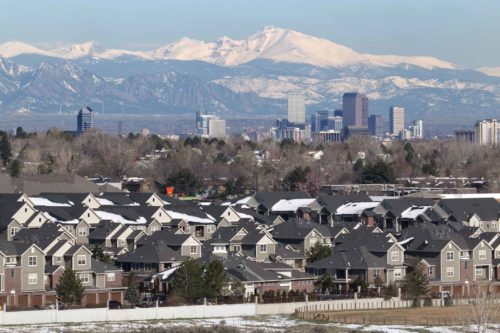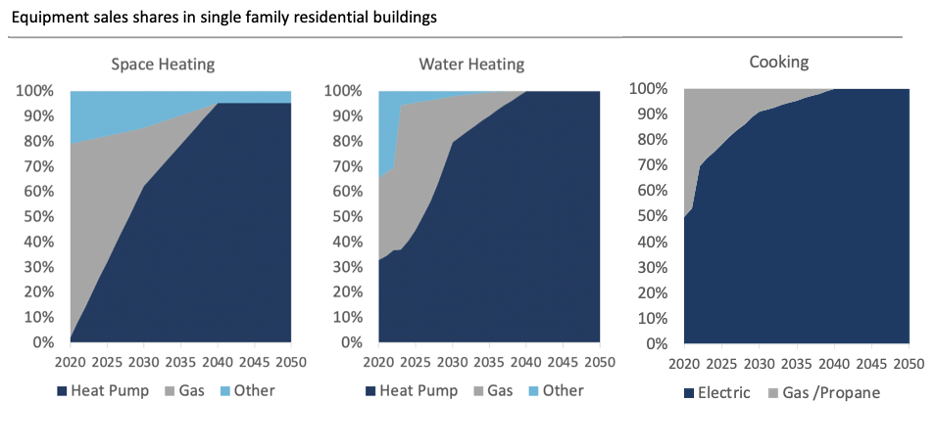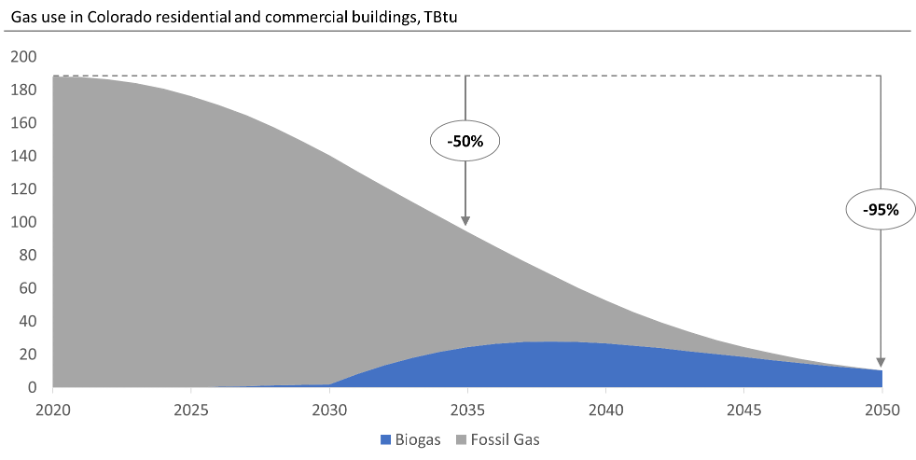The snow covered Longs Peak and the Rocky Mountains stand behind Downtown Denver skyscrapers, hotels, office and apartment buildings with homes and condos in the foreground.

Colorado Won’t Meet Climate Goals without Swift Action on Buildings
Colorado officials recently released their long-awaited draft Greenhouse Gas Pollution Reduction Roadmap, laying out a path toward achieving the state’s goals of a 50 percent reduction in carbon emissions by 2030 and 90 percent by 2050. The roadmap takes stock of Colorado’s emissions across sectors, such as transportation, electricity, and buildings. It then identifies a series of policy actions needed to meet the state’s climate targets while minimizing the social, economic, and health impact on communities.
While transportation and electricity are the state’s two largest contributors to climate change, Colorado officials recognize they won’t achieve their climate goals unless they tackle both direct and indirect emissions from a more stubborn sector: buildings. Buildings are responsible for 28 percent of the state’s carbon emissions, with 9 percent stemming from burning fossil fuels to heat space and water. The roadmap is clear that current policies do not put the state on track to meet its 2025 and 2030 emissions reduction goals and that more action will be needed across all sectors.
The roadmap proposes dramatic changes in the buildings sector. Achieving these goals would require heat pumps to provide over 90 percent of space heating in the state’s residential and commercial buildings and nearly 100 percent of water heating by 2050, according to RMI analysis. This is paired with expanded energy efficiency investments and phasing out fossil gas distribution to homes and businesses. Moreover, policy measures that support the adoption of advanced building codes and support consumer adoption of technologies like electric heat pumps are identified as key to achieving near-term actions.
While the draft roadmap is an important step toward addressing building emissions, the pace of change required relies on significant gains after 2030, and rapid efforts to jumpstart this transformation in the near term will be critical to success. Existing actions are inadequate to drive this scale of transformation, and the state must quickly implement new programs, policies, and regulations to meet these goals.
Colorado’s Building Decarbonization Roadmap
The roadmap envisions a dramatic transformation of the buildings sector by 2050, requiring almost a full phase-out of gas for space and water heating as well as ambitious market development strategies. Heat pumps would comprise over 60 percent of residential heating equipment sales by 2030 and over 95 percent by 2040, up from 2 percent today. This will require a major market transformation. Sales of gas furnaces and boilers would peak in 2021 before starting a steep decline to zero. Commercial heating equipment sales would transform even more quickly. By 2050, more than 90 percent of space and water heating would be electric across Colorado’s buildings.

As ambitious as this transformation would be, there is value in moving even faster. The draft roadmap states, “vehicle and building electrification are very effective at reducing pollution but will take time to ramp up in adoption.” This means an earlier and more aggressive start to this transition can be an effective strategy if executed successfully. Given the rate of stock turnover and infrastructure investments needed, rapid increases in sales of carbon-free equipment like heat pumps over the next few years will pay large dividends in the future.
The Missing Pieces
To date, Colorado has not established the necessary policies and programs to meet these targets. Last year, the state passed House Bill 19-1231 to expand the number of products covered under appliance efficiency standards. Lawmakers also updated the building energy code statute under House Bill 19-1260, requiring local building codes to adhere to one of the three most recent International Energy Conservation Code (IECC) standards.
The draft roadmap recommends additional actions, including benchmarking and performance standards for large commercial buildings, new heat pump programs from utilities, and advanced building codes. These are all important, but explicit electrification requirements and concrete phase-out strategies for gas in buildings are essential for fully decarbonizing the buildings sector.
Although the roadmap’s objective is to facilitate the adoption of concrete regulatory policies on emissions reduction pathways that ensure a just and equitable transition, this remains largely uncertain within the document itself. To ensure the transformation of the buildings sector progresses at the pace required, more assertive actions will be needed.
The roadmap sets a target to ensure that fossil fuel equipment is phased out of 90 percent of buildings and a majority of buildings receive efficiency upgrades by 2050. In order to do this, the state needs clear requirements to electrify new buildings as soon as possible, expanded initiatives to build the market for carbon-free heating technologies, and additional efficiency programs as a backstop. But without clear policy requirements, there is significant uncertainty regarding the best way to coordinate across the state to meet emissions targets.
Moreover, it is unclear how these policies will ultimately impact low-income communities, assist in the just transition of the workforce, and support Colorado’s economy. However, this is essential to driving action forward. Legislation and new state policies and partnerships implemented progressively over time will be essential to achieve the level of emissions reductions needed.
Additionally, the draft roadmap anticipates gas consumption among residential and commercial buildings falling 50 percent by 2035 and 95 percent by 2050, according to RMI analysis, with a small amount of biogas serving remaining needs. This prospect poses major questions that the Colorado Public Utilities Commission will need to address, including how investments should be scaled back now to avoid over-investing in a gas distribution system that could be substantially underutilized. Given the time required to adopt and implement legislation and make the necessary investments to transition our infrastructure, regulators must start the process now.

What Happens Next
With this roadmap, Colorado is one of few states to explicitly recognize the need to transform the buildings sector with dramatic reductions in gas use in order to meet climate goals. The transition towards electrification needs to increase rapidly and there are clear climate, health, and economic benefits to doing so.
The draft report is now moving into a month-long public comment period. This provides a critical window to help inform potential policies and measures, as well as the overall direction for how Colorado should set a precedent for building electrification going forward. Now it is essential that state and city policymakers and regulators act to ensure this roadmap becomes reality.